National Asthma Strategy: Impact on Nursing & Healthcare in Australia
VerifiedAdded on 2023/05/30
|10
|2470
|319
Essay
AI Summary
This essay provides a detailed analysis of the National Asthma Strategy (NAS) by the National Asthma Council Australia (NACA) and its impact on nursing practice and the Australian healthcare system. It examines the strategy's objectives, including self-management practices, best-practice asthma management, equitable healthcare access, risk reduction, and evidence-based practices. The essay explores how these objectives influence nursing roles, such as health education, early diagnosis, multidisciplinary teamwork, and the integration of new technologies like telemedicine and digital health records. It emphasizes the importance of culturally competent care for Aboriginal and Torres Strait Islander populations and advocates for changes in the healthcare system to support the strategy's implementation, including community-level campaigns, school-based interventions, and technological advancements. The conclusion highlights the need for government support and modifications in nursing practice to achieve optimal outcomes in asthma management and prevention.
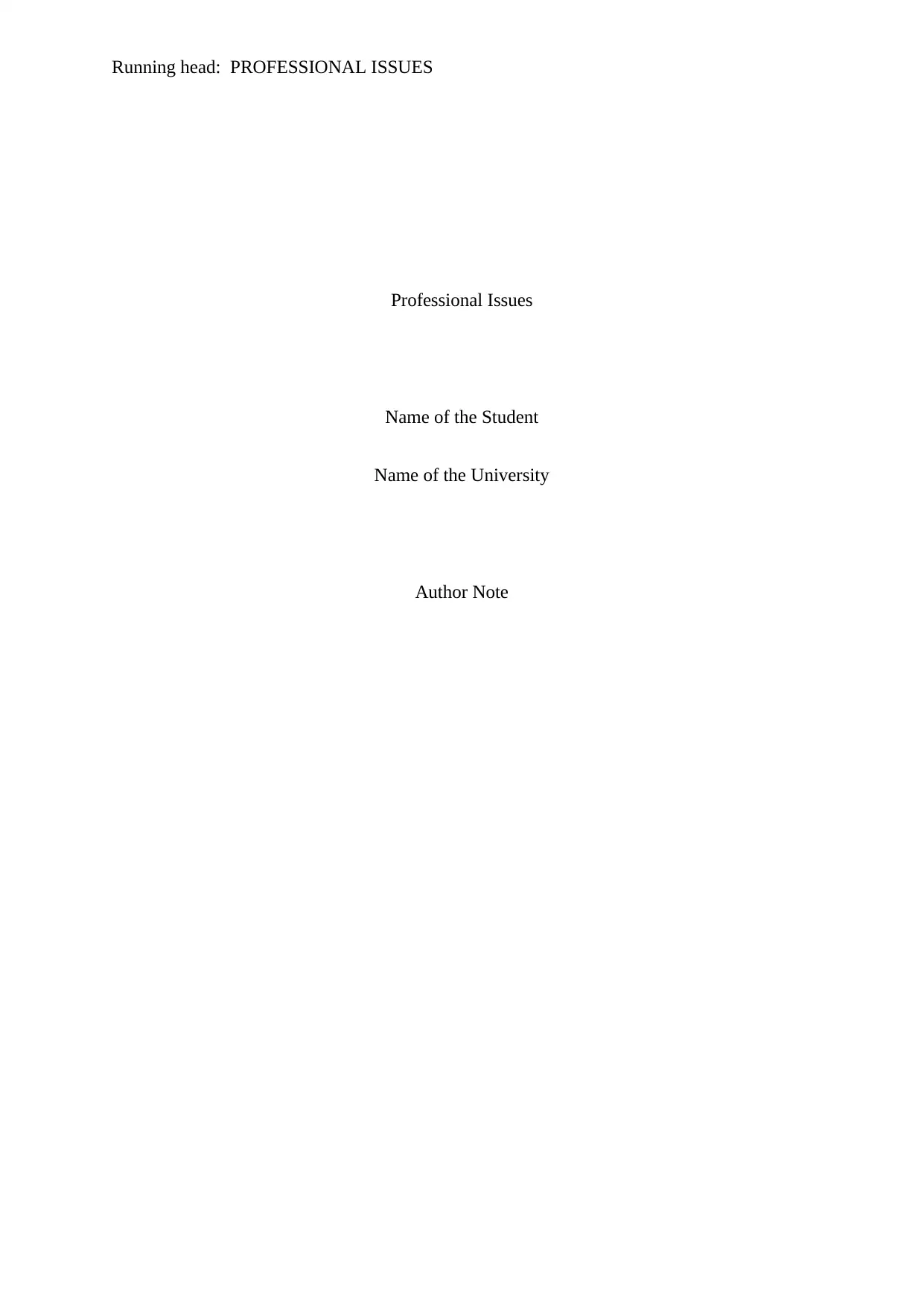
Running head: PROFESSIONAL ISSUES
Professional Issues
Name of the Student
Name of the University
Author Note
Professional Issues
Name of the Student
Name of the University
Author Note
Paraphrase This Document
Need a fresh take? Get an instant paraphrase of this document with our AI Paraphraser
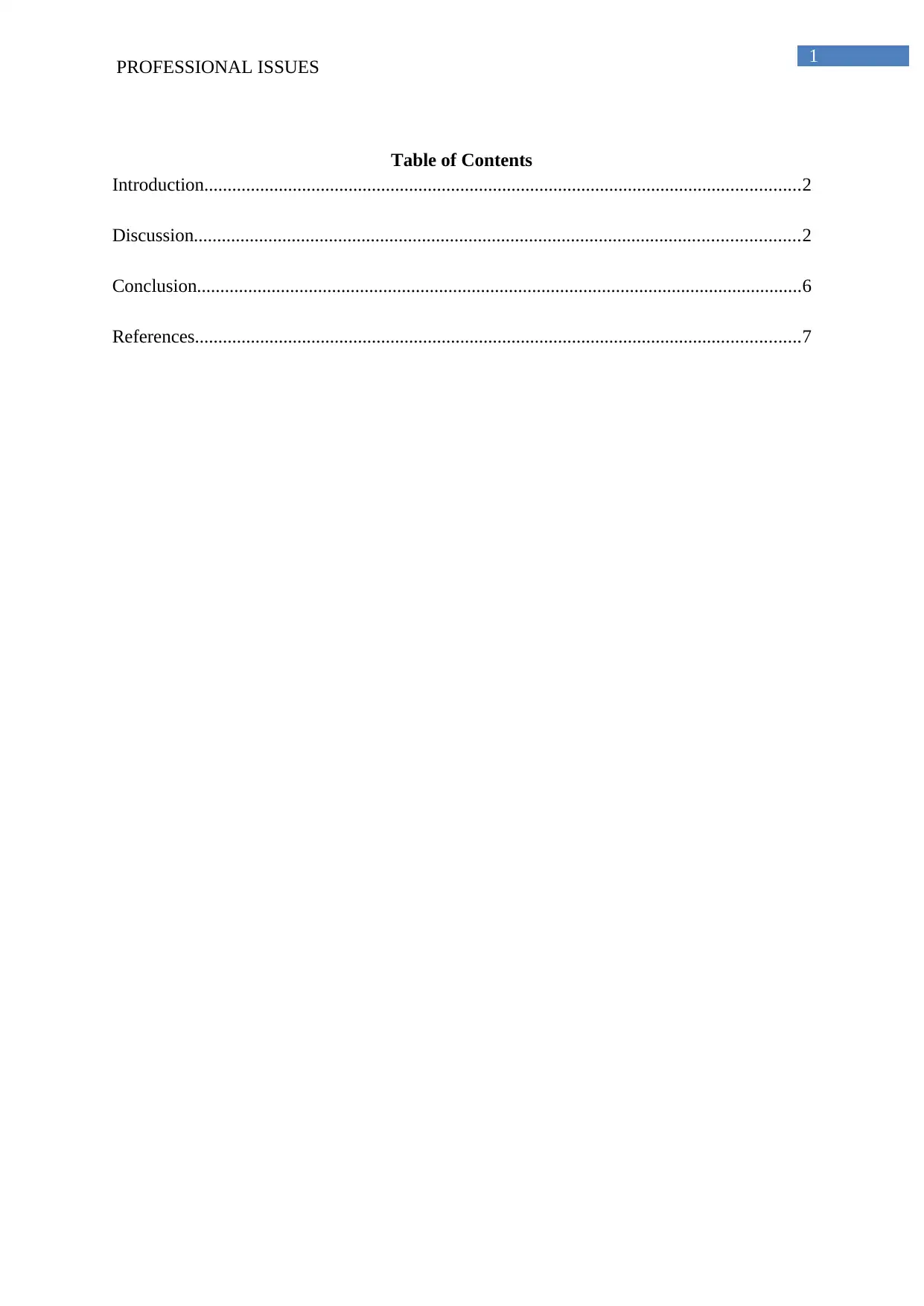
1
PROFESSIONAL ISSUES
Table of Contents
Introduction................................................................................................................................2
Discussion..................................................................................................................................2
Conclusion..................................................................................................................................6
References..................................................................................................................................7
PROFESSIONAL ISSUES
Table of Contents
Introduction................................................................................................................................2
Discussion..................................................................................................................................2
Conclusion..................................................................................................................................6
References..................................................................................................................................7
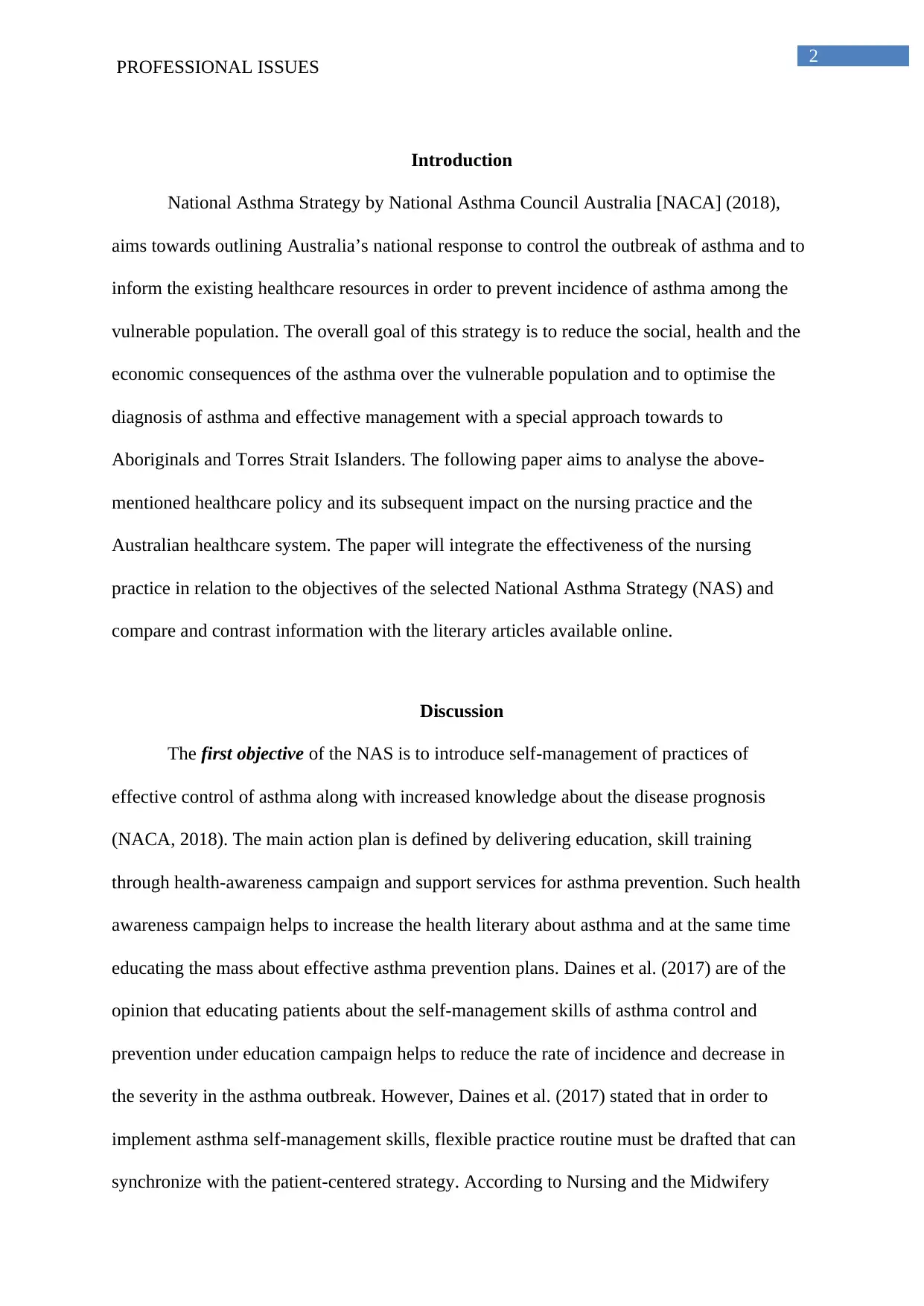
2
PROFESSIONAL ISSUES
Introduction
National Asthma Strategy by National Asthma Council Australia [NACA] (2018),
aims towards outlining Australia’s national response to control the outbreak of asthma and to
inform the existing healthcare resources in order to prevent incidence of asthma among the
vulnerable population. The overall goal of this strategy is to reduce the social, health and the
economic consequences of the asthma over the vulnerable population and to optimise the
diagnosis of asthma and effective management with a special approach towards to
Aboriginals and Torres Strait Islanders. The following paper aims to analyse the above-
mentioned healthcare policy and its subsequent impact on the nursing practice and the
Australian healthcare system. The paper will integrate the effectiveness of the nursing
practice in relation to the objectives of the selected National Asthma Strategy (NAS) and
compare and contrast information with the literary articles available online.
Discussion
The first objective of the NAS is to introduce self-management of practices of
effective control of asthma along with increased knowledge about the disease prognosis
(NACA, 2018). The main action plan is defined by delivering education, skill training
through health-awareness campaign and support services for asthma prevention. Such health
awareness campaign helps to increase the health literary about asthma and at the same time
educating the mass about effective asthma prevention plans. Daines et al. (2017) are of the
opinion that educating patients about the self-management skills of asthma control and
prevention under education campaign helps to reduce the rate of incidence and decrease in
the severity in the asthma outbreak. However, Daines et al. (2017) stated that in order to
implement asthma self-management skills, flexible practice routine must be drafted that can
synchronize with the patient-centered strategy. According to Nursing and the Midwifery
PROFESSIONAL ISSUES
Introduction
National Asthma Strategy by National Asthma Council Australia [NACA] (2018),
aims towards outlining Australia’s national response to control the outbreak of asthma and to
inform the existing healthcare resources in order to prevent incidence of asthma among the
vulnerable population. The overall goal of this strategy is to reduce the social, health and the
economic consequences of the asthma over the vulnerable population and to optimise the
diagnosis of asthma and effective management with a special approach towards to
Aboriginals and Torres Strait Islanders. The following paper aims to analyse the above-
mentioned healthcare policy and its subsequent impact on the nursing practice and the
Australian healthcare system. The paper will integrate the effectiveness of the nursing
practice in relation to the objectives of the selected National Asthma Strategy (NAS) and
compare and contrast information with the literary articles available online.
Discussion
The first objective of the NAS is to introduce self-management of practices of
effective control of asthma along with increased knowledge about the disease prognosis
(NACA, 2018). The main action plan is defined by delivering education, skill training
through health-awareness campaign and support services for asthma prevention. Such health
awareness campaign helps to increase the health literary about asthma and at the same time
educating the mass about effective asthma prevention plans. Daines et al. (2017) are of the
opinion that educating patients about the self-management skills of asthma control and
prevention under education campaign helps to reduce the rate of incidence and decrease in
the severity in the asthma outbreak. However, Daines et al. (2017) stated that in order to
implement asthma self-management skills, flexible practice routine must be drafted that can
synchronize with the patient-centered strategy. According to Nursing and the Midwifery
⊘ This is a preview!⊘
Do you want full access?
Subscribe today to unlock all pages.

Trusted by 1+ million students worldwide
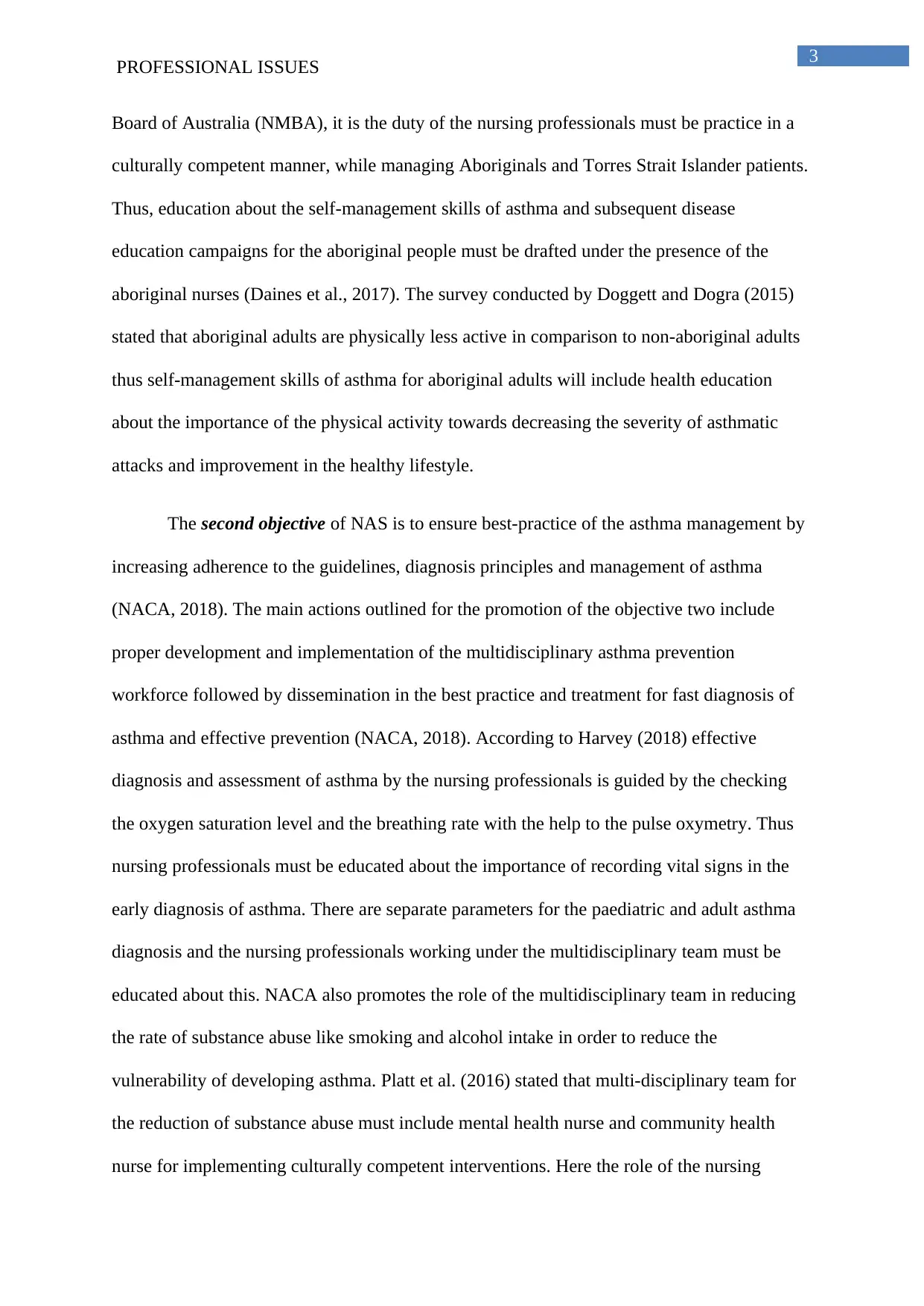
3
PROFESSIONAL ISSUES
Board of Australia (NMBA), it is the duty of the nursing professionals must be practice in a
culturally competent manner, while managing Aboriginals and Torres Strait Islander patients.
Thus, education about the self-management skills of asthma and subsequent disease
education campaigns for the aboriginal people must be drafted under the presence of the
aboriginal nurses (Daines et al., 2017). The survey conducted by Doggett and Dogra (2015)
stated that aboriginal adults are physically less active in comparison to non-aboriginal adults
thus self-management skills of asthma for aboriginal adults will include health education
about the importance of the physical activity towards decreasing the severity of asthmatic
attacks and improvement in the healthy lifestyle.
The second objective of NAS is to ensure best-practice of the asthma management by
increasing adherence to the guidelines, diagnosis principles and management of asthma
(NACA, 2018). The main actions outlined for the promotion of the objective two include
proper development and implementation of the multidisciplinary asthma prevention
workforce followed by dissemination in the best practice and treatment for fast diagnosis of
asthma and effective prevention (NACA, 2018). According to Harvey (2018) effective
diagnosis and assessment of asthma by the nursing professionals is guided by the checking
the oxygen saturation level and the breathing rate with the help to the pulse oxymetry. Thus
nursing professionals must be educated about the importance of recording vital signs in the
early diagnosis of asthma. There are separate parameters for the paediatric and adult asthma
diagnosis and the nursing professionals working under the multidisciplinary team must be
educated about this. NACA also promotes the role of the multidisciplinary team in reducing
the rate of substance abuse like smoking and alcohol intake in order to reduce the
vulnerability of developing asthma. Platt et al. (2016) stated that multi-disciplinary team for
the reduction of substance abuse must include mental health nurse and community health
nurse for implementing culturally competent interventions. Here the role of the nursing
PROFESSIONAL ISSUES
Board of Australia (NMBA), it is the duty of the nursing professionals must be practice in a
culturally competent manner, while managing Aboriginals and Torres Strait Islander patients.
Thus, education about the self-management skills of asthma and subsequent disease
education campaigns for the aboriginal people must be drafted under the presence of the
aboriginal nurses (Daines et al., 2017). The survey conducted by Doggett and Dogra (2015)
stated that aboriginal adults are physically less active in comparison to non-aboriginal adults
thus self-management skills of asthma for aboriginal adults will include health education
about the importance of the physical activity towards decreasing the severity of asthmatic
attacks and improvement in the healthy lifestyle.
The second objective of NAS is to ensure best-practice of the asthma management by
increasing adherence to the guidelines, diagnosis principles and management of asthma
(NACA, 2018). The main actions outlined for the promotion of the objective two include
proper development and implementation of the multidisciplinary asthma prevention
workforce followed by dissemination in the best practice and treatment for fast diagnosis of
asthma and effective prevention (NACA, 2018). According to Harvey (2018) effective
diagnosis and assessment of asthma by the nursing professionals is guided by the checking
the oxygen saturation level and the breathing rate with the help to the pulse oxymetry. Thus
nursing professionals must be educated about the importance of recording vital signs in the
early diagnosis of asthma. There are separate parameters for the paediatric and adult asthma
diagnosis and the nursing professionals working under the multidisciplinary team must be
educated about this. NACA also promotes the role of the multidisciplinary team in reducing
the rate of substance abuse like smoking and alcohol intake in order to reduce the
vulnerability of developing asthma. Platt et al. (2016) stated that multi-disciplinary team for
the reduction of substance abuse must include mental health nurse and community health
nurse for implementing culturally competent interventions. Here the role of the nursing
Paraphrase This Document
Need a fresh take? Get an instant paraphrase of this document with our AI Paraphraser
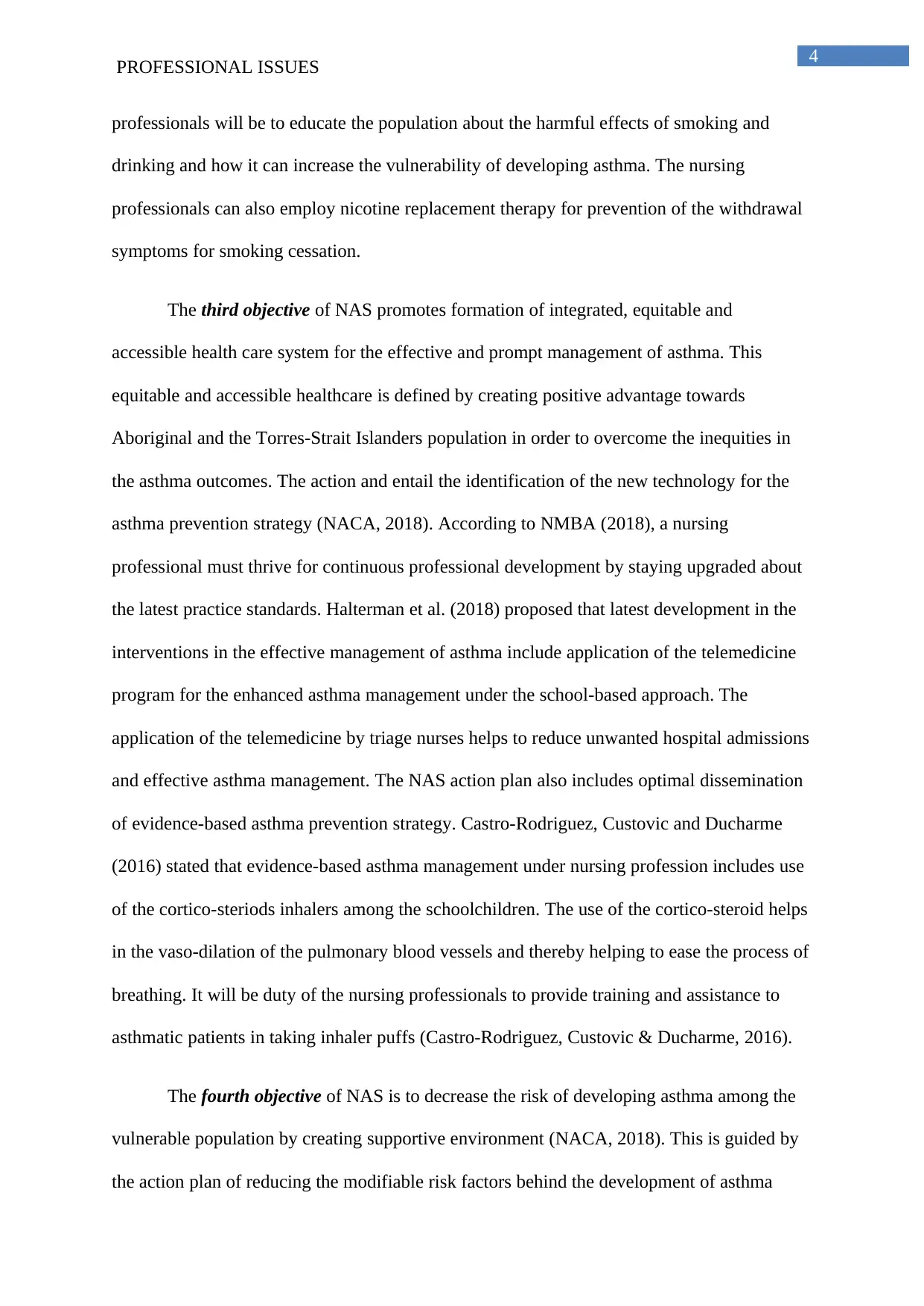
4
PROFESSIONAL ISSUES
professionals will be to educate the population about the harmful effects of smoking and
drinking and how it can increase the vulnerability of developing asthma. The nursing
professionals can also employ nicotine replacement therapy for prevention of the withdrawal
symptoms for smoking cessation.
The third objective of NAS promotes formation of integrated, equitable and
accessible health care system for the effective and prompt management of asthma. This
equitable and accessible healthcare is defined by creating positive advantage towards
Aboriginal and the Torres-Strait Islanders population in order to overcome the inequities in
the asthma outcomes. The action and entail the identification of the new technology for the
asthma prevention strategy (NACA, 2018). According to NMBA (2018), a nursing
professional must thrive for continuous professional development by staying upgraded about
the latest practice standards. Halterman et al. (2018) proposed that latest development in the
interventions in the effective management of asthma include application of the telemedicine
program for the enhanced asthma management under the school-based approach. The
application of the telemedicine by triage nurses helps to reduce unwanted hospital admissions
and effective asthma management. The NAS action plan also includes optimal dissemination
of evidence-based asthma prevention strategy. Castro-Rodriguez, Custovic and Ducharme
(2016) stated that evidence-based asthma management under nursing profession includes use
of the cortico-steriods inhalers among the schoolchildren. The use of the cortico-steroid helps
in the vaso-dilation of the pulmonary blood vessels and thereby helping to ease the process of
breathing. It will be duty of the nursing professionals to provide training and assistance to
asthmatic patients in taking inhaler puffs (Castro-Rodriguez, Custovic & Ducharme, 2016).
The fourth objective of NAS is to decrease the risk of developing asthma among the
vulnerable population by creating supportive environment (NACA, 2018). This is guided by
the action plan of reducing the modifiable risk factors behind the development of asthma
PROFESSIONAL ISSUES
professionals will be to educate the population about the harmful effects of smoking and
drinking and how it can increase the vulnerability of developing asthma. The nursing
professionals can also employ nicotine replacement therapy for prevention of the withdrawal
symptoms for smoking cessation.
The third objective of NAS promotes formation of integrated, equitable and
accessible health care system for the effective and prompt management of asthma. This
equitable and accessible healthcare is defined by creating positive advantage towards
Aboriginal and the Torres-Strait Islanders population in order to overcome the inequities in
the asthma outcomes. The action and entail the identification of the new technology for the
asthma prevention strategy (NACA, 2018). According to NMBA (2018), a nursing
professional must thrive for continuous professional development by staying upgraded about
the latest practice standards. Halterman et al. (2018) proposed that latest development in the
interventions in the effective management of asthma include application of the telemedicine
program for the enhanced asthma management under the school-based approach. The
application of the telemedicine by triage nurses helps to reduce unwanted hospital admissions
and effective asthma management. The NAS action plan also includes optimal dissemination
of evidence-based asthma prevention strategy. Castro-Rodriguez, Custovic and Ducharme
(2016) stated that evidence-based asthma management under nursing profession includes use
of the cortico-steriods inhalers among the schoolchildren. The use of the cortico-steroid helps
in the vaso-dilation of the pulmonary blood vessels and thereby helping to ease the process of
breathing. It will be duty of the nursing professionals to provide training and assistance to
asthmatic patients in taking inhaler puffs (Castro-Rodriguez, Custovic & Ducharme, 2016).
The fourth objective of NAS is to decrease the risk of developing asthma among the
vulnerable population by creating supportive environment (NACA, 2018). This is guided by
the action plan of reducing the modifiable risk factors behind the development of asthma
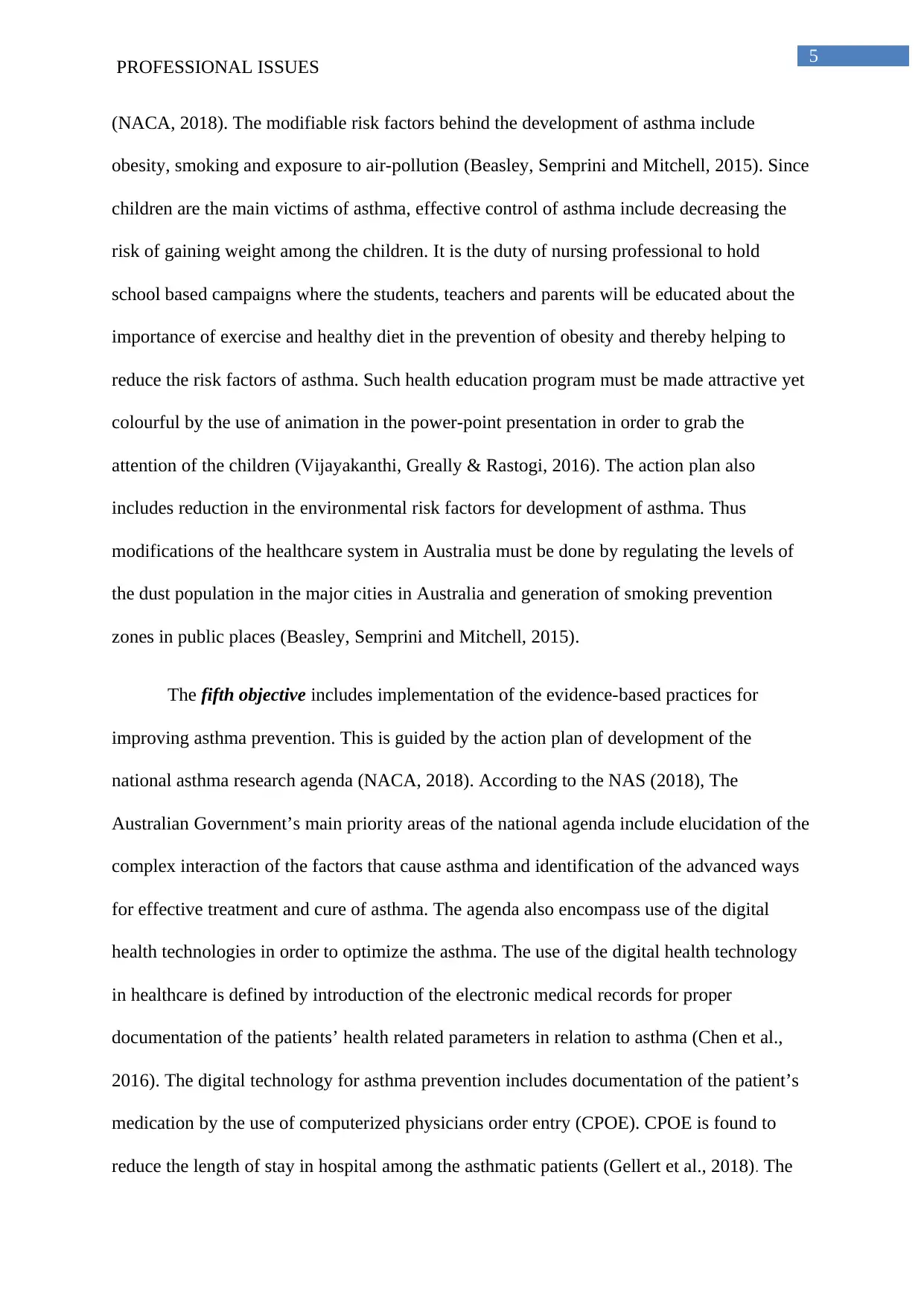
5
PROFESSIONAL ISSUES
(NACA, 2018). The modifiable risk factors behind the development of asthma include
obesity, smoking and exposure to air-pollution (Beasley, Semprini and Mitchell, 2015). Since
children are the main victims of asthma, effective control of asthma include decreasing the
risk of gaining weight among the children. It is the duty of nursing professional to hold
school based campaigns where the students, teachers and parents will be educated about the
importance of exercise and healthy diet in the prevention of obesity and thereby helping to
reduce the risk factors of asthma. Such health education program must be made attractive yet
colourful by the use of animation in the power-point presentation in order to grab the
attention of the children (Vijayakanthi, Greally & Rastogi, 2016). The action plan also
includes reduction in the environmental risk factors for development of asthma. Thus
modifications of the healthcare system in Australia must be done by regulating the levels of
the dust population in the major cities in Australia and generation of smoking prevention
zones in public places (Beasley, Semprini and Mitchell, 2015).
The fifth objective includes implementation of the evidence-based practices for
improving asthma prevention. This is guided by the action plan of development of the
national asthma research agenda (NACA, 2018). According to the NAS (2018), The
Australian Government’s main priority areas of the national agenda include elucidation of the
complex interaction of the factors that cause asthma and identification of the advanced ways
for effective treatment and cure of asthma. The agenda also encompass use of the digital
health technologies in order to optimize the asthma. The use of the digital health technology
in healthcare is defined by introduction of the electronic medical records for proper
documentation of the patients’ health related parameters in relation to asthma (Chen et al.,
2016). The digital technology for asthma prevention includes documentation of the patient’s
medication by the use of computerized physicians order entry (CPOE). CPOE is found to
reduce the length of stay in hospital among the asthmatic patients (Gellert et al., 2018). The
PROFESSIONAL ISSUES
(NACA, 2018). The modifiable risk factors behind the development of asthma include
obesity, smoking and exposure to air-pollution (Beasley, Semprini and Mitchell, 2015). Since
children are the main victims of asthma, effective control of asthma include decreasing the
risk of gaining weight among the children. It is the duty of nursing professional to hold
school based campaigns where the students, teachers and parents will be educated about the
importance of exercise and healthy diet in the prevention of obesity and thereby helping to
reduce the risk factors of asthma. Such health education program must be made attractive yet
colourful by the use of animation in the power-point presentation in order to grab the
attention of the children (Vijayakanthi, Greally & Rastogi, 2016). The action plan also
includes reduction in the environmental risk factors for development of asthma. Thus
modifications of the healthcare system in Australia must be done by regulating the levels of
the dust population in the major cities in Australia and generation of smoking prevention
zones in public places (Beasley, Semprini and Mitchell, 2015).
The fifth objective includes implementation of the evidence-based practices for
improving asthma prevention. This is guided by the action plan of development of the
national asthma research agenda (NACA, 2018). According to the NAS (2018), The
Australian Government’s main priority areas of the national agenda include elucidation of the
complex interaction of the factors that cause asthma and identification of the advanced ways
for effective treatment and cure of asthma. The agenda also encompass use of the digital
health technologies in order to optimize the asthma. The use of the digital health technology
in healthcare is defined by introduction of the electronic medical records for proper
documentation of the patients’ health related parameters in relation to asthma (Chen et al.,
2016). The digital technology for asthma prevention includes documentation of the patient’s
medication by the use of computerized physicians order entry (CPOE). CPOE is found to
reduce the length of stay in hospital among the asthmatic patients (Gellert et al., 2018). The
⊘ This is a preview!⊘
Do you want full access?
Subscribe today to unlock all pages.

Trusted by 1+ million students worldwide
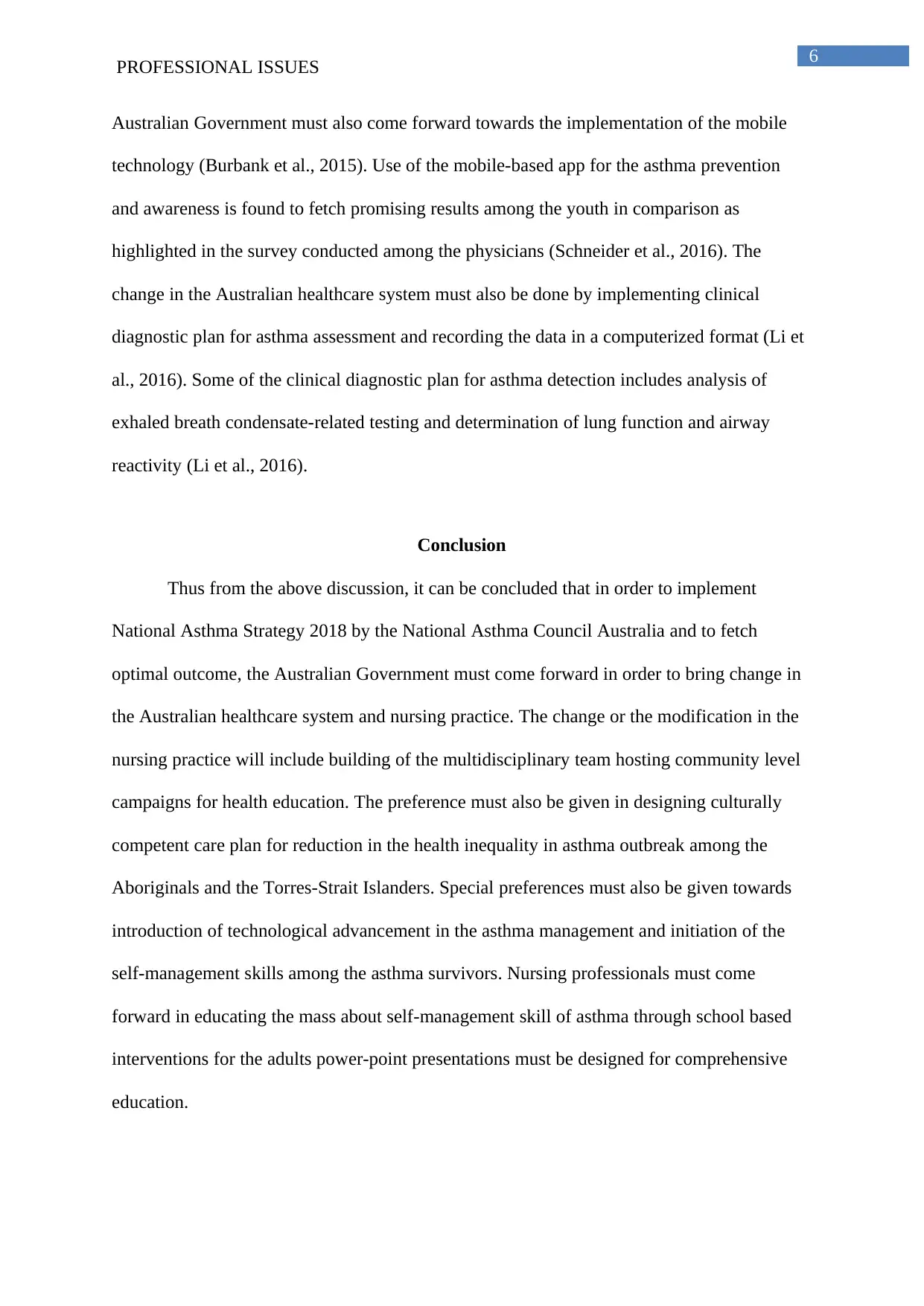
6
PROFESSIONAL ISSUES
Australian Government must also come forward towards the implementation of the mobile
technology (Burbank et al., 2015). Use of the mobile-based app for the asthma prevention
and awareness is found to fetch promising results among the youth in comparison as
highlighted in the survey conducted among the physicians (Schneider et al., 2016). The
change in the Australian healthcare system must also be done by implementing clinical
diagnostic plan for asthma assessment and recording the data in a computerized format (Li et
al., 2016). Some of the clinical diagnostic plan for asthma detection includes analysis of
exhaled breath condensate-related testing and determination of lung function and airway
reactivity (Li et al., 2016).
Conclusion
Thus from the above discussion, it can be concluded that in order to implement
National Asthma Strategy 2018 by the National Asthma Council Australia and to fetch
optimal outcome, the Australian Government must come forward in order to bring change in
the Australian healthcare system and nursing practice. The change or the modification in the
nursing practice will include building of the multidisciplinary team hosting community level
campaigns for health education. The preference must also be given in designing culturally
competent care plan for reduction in the health inequality in asthma outbreak among the
Aboriginals and the Torres-Strait Islanders. Special preferences must also be given towards
introduction of technological advancement in the asthma management and initiation of the
self-management skills among the asthma survivors. Nursing professionals must come
forward in educating the mass about self-management skill of asthma through school based
interventions for the adults power-point presentations must be designed for comprehensive
education.
PROFESSIONAL ISSUES
Australian Government must also come forward towards the implementation of the mobile
technology (Burbank et al., 2015). Use of the mobile-based app for the asthma prevention
and awareness is found to fetch promising results among the youth in comparison as
highlighted in the survey conducted among the physicians (Schneider et al., 2016). The
change in the Australian healthcare system must also be done by implementing clinical
diagnostic plan for asthma assessment and recording the data in a computerized format (Li et
al., 2016). Some of the clinical diagnostic plan for asthma detection includes analysis of
exhaled breath condensate-related testing and determination of lung function and airway
reactivity (Li et al., 2016).
Conclusion
Thus from the above discussion, it can be concluded that in order to implement
National Asthma Strategy 2018 by the National Asthma Council Australia and to fetch
optimal outcome, the Australian Government must come forward in order to bring change in
the Australian healthcare system and nursing practice. The change or the modification in the
nursing practice will include building of the multidisciplinary team hosting community level
campaigns for health education. The preference must also be given in designing culturally
competent care plan for reduction in the health inequality in asthma outbreak among the
Aboriginals and the Torres-Strait Islanders. Special preferences must also be given towards
introduction of technological advancement in the asthma management and initiation of the
self-management skills among the asthma survivors. Nursing professionals must come
forward in educating the mass about self-management skill of asthma through school based
interventions for the adults power-point presentations must be designed for comprehensive
education.
Paraphrase This Document
Need a fresh take? Get an instant paraphrase of this document with our AI Paraphraser
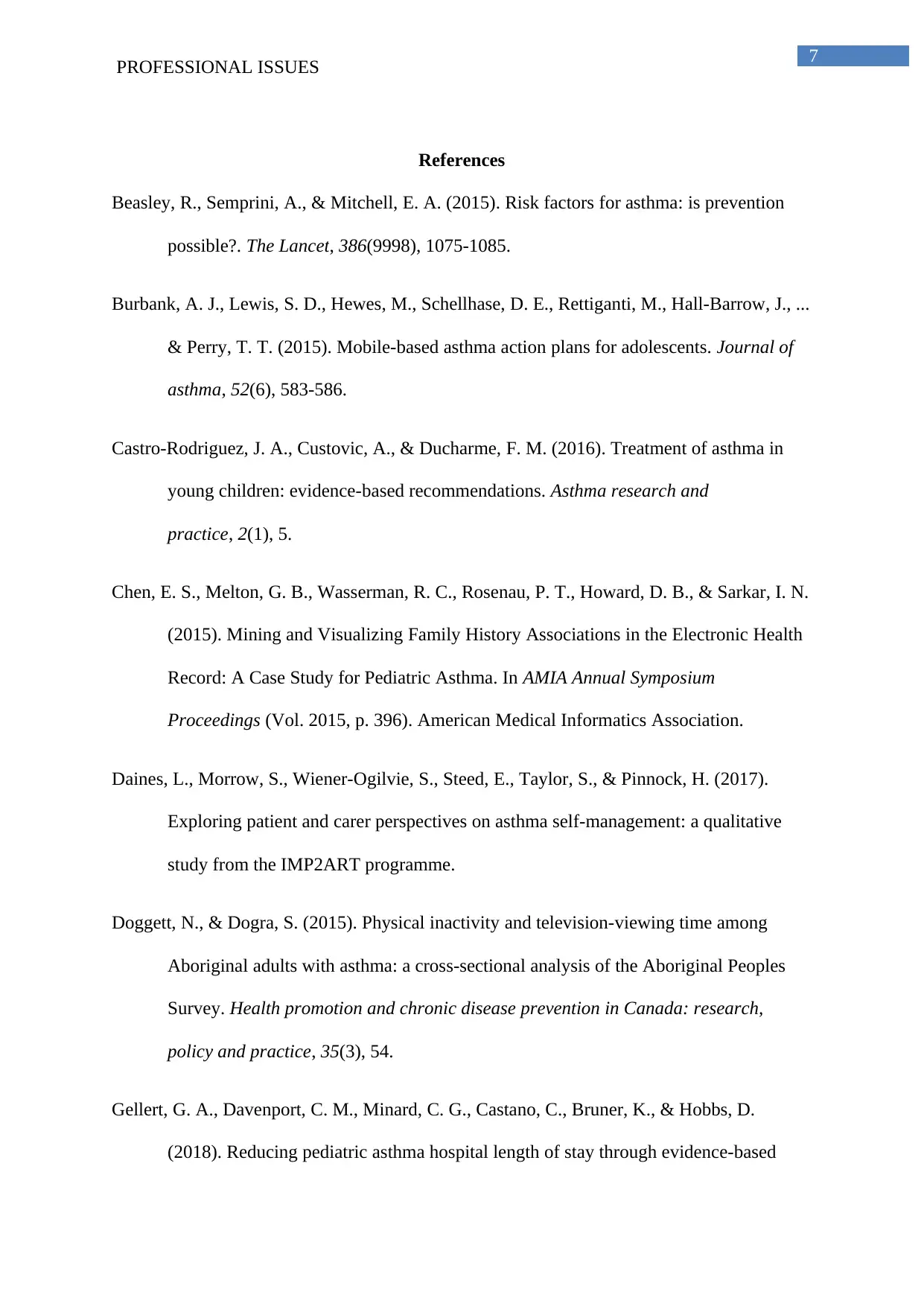
7
PROFESSIONAL ISSUES
References
Beasley, R., Semprini, A., & Mitchell, E. A. (2015). Risk factors for asthma: is prevention
possible?. The Lancet, 386(9998), 1075-1085.
Burbank, A. J., Lewis, S. D., Hewes, M., Schellhase, D. E., Rettiganti, M., Hall-Barrow, J., ...
& Perry, T. T. (2015). Mobile-based asthma action plans for adolescents. Journal of
asthma, 52(6), 583-586.
Castro-Rodriguez, J. A., Custovic, A., & Ducharme, F. M. (2016). Treatment of asthma in
young children: evidence-based recommendations. Asthma research and
practice, 2(1), 5.
Chen, E. S., Melton, G. B., Wasserman, R. C., Rosenau, P. T., Howard, D. B., & Sarkar, I. N.
(2015). Mining and Visualizing Family History Associations in the Electronic Health
Record: A Case Study for Pediatric Asthma. In AMIA Annual Symposium
Proceedings (Vol. 2015, p. 396). American Medical Informatics Association.
Daines, L., Morrow, S., Wiener-Ogilvie, S., Steed, E., Taylor, S., & Pinnock, H. (2017).
Exploring patient and carer perspectives on asthma self-management: a qualitative
study from the IMP2ART programme.
Doggett, N., & Dogra, S. (2015). Physical inactivity and television-viewing time among
Aboriginal adults with asthma: a cross-sectional analysis of the Aboriginal Peoples
Survey. Health promotion and chronic disease prevention in Canada: research,
policy and practice, 35(3), 54.
Gellert, G. A., Davenport, C. M., Minard, C. G., Castano, C., Bruner, K., & Hobbs, D.
(2018). Reducing pediatric asthma hospital length of stay through evidence-based
PROFESSIONAL ISSUES
References
Beasley, R., Semprini, A., & Mitchell, E. A. (2015). Risk factors for asthma: is prevention
possible?. The Lancet, 386(9998), 1075-1085.
Burbank, A. J., Lewis, S. D., Hewes, M., Schellhase, D. E., Rettiganti, M., Hall-Barrow, J., ...
& Perry, T. T. (2015). Mobile-based asthma action plans for adolescents. Journal of
asthma, 52(6), 583-586.
Castro-Rodriguez, J. A., Custovic, A., & Ducharme, F. M. (2016). Treatment of asthma in
young children: evidence-based recommendations. Asthma research and
practice, 2(1), 5.
Chen, E. S., Melton, G. B., Wasserman, R. C., Rosenau, P. T., Howard, D. B., & Sarkar, I. N.
(2015). Mining and Visualizing Family History Associations in the Electronic Health
Record: A Case Study for Pediatric Asthma. In AMIA Annual Symposium
Proceedings (Vol. 2015, p. 396). American Medical Informatics Association.
Daines, L., Morrow, S., Wiener-Ogilvie, S., Steed, E., Taylor, S., & Pinnock, H. (2017).
Exploring patient and carer perspectives on asthma self-management: a qualitative
study from the IMP2ART programme.
Doggett, N., & Dogra, S. (2015). Physical inactivity and television-viewing time among
Aboriginal adults with asthma: a cross-sectional analysis of the Aboriginal Peoples
Survey. Health promotion and chronic disease prevention in Canada: research,
policy and practice, 35(3), 54.
Gellert, G. A., Davenport, C. M., Minard, C. G., Castano, C., Bruner, K., & Hobbs, D.
(2018). Reducing pediatric asthma hospital length of stay through evidence-based
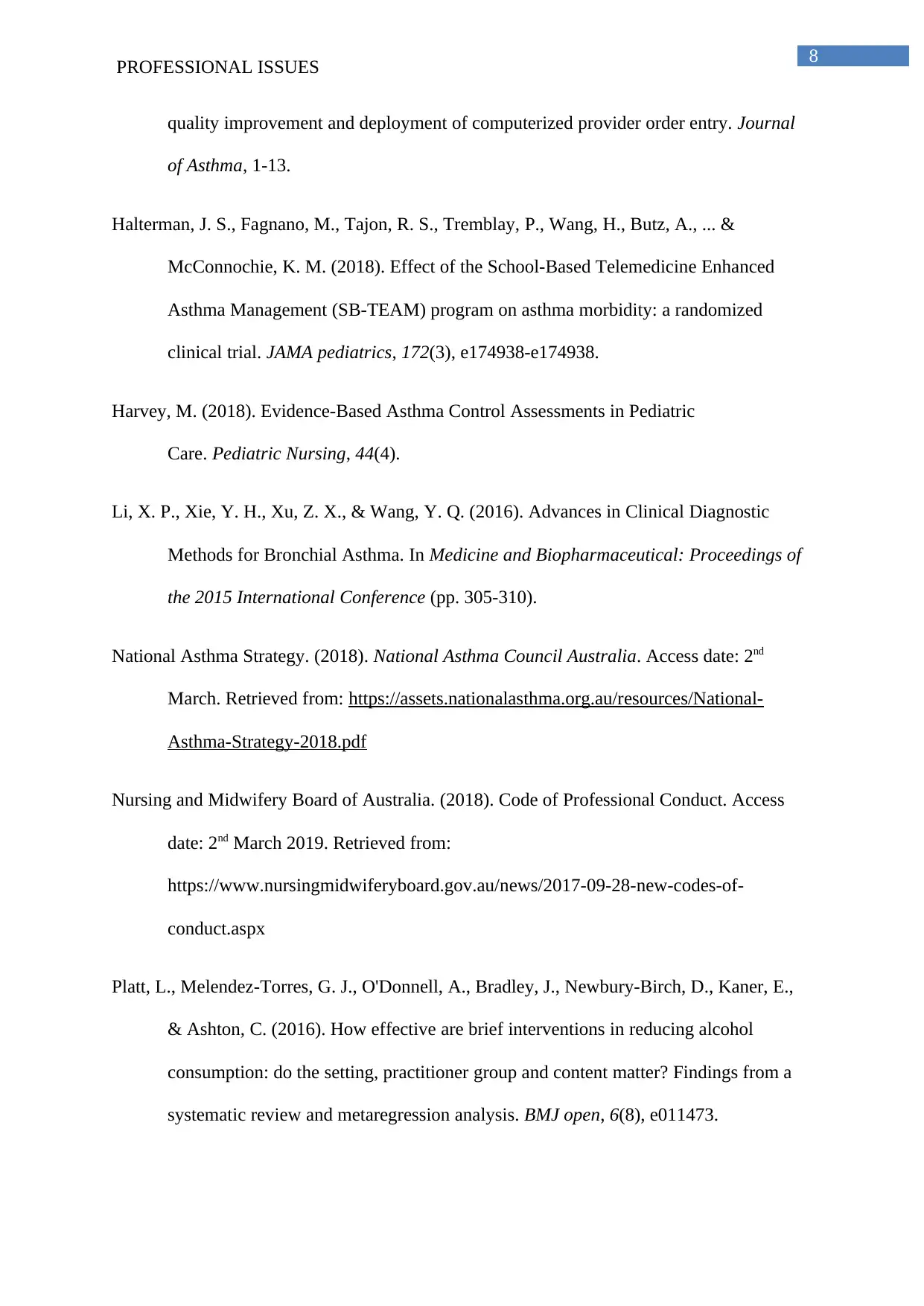
8
PROFESSIONAL ISSUES
quality improvement and deployment of computerized provider order entry. Journal
of Asthma, 1-13.
Halterman, J. S., Fagnano, M., Tajon, R. S., Tremblay, P., Wang, H., Butz, A., ... &
McConnochie, K. M. (2018). Effect of the School-Based Telemedicine Enhanced
Asthma Management (SB-TEAM) program on asthma morbidity: a randomized
clinical trial. JAMA pediatrics, 172(3), e174938-e174938.
Harvey, M. (2018). Evidence-Based Asthma Control Assessments in Pediatric
Care. Pediatric Nursing, 44(4).
Li, X. P., Xie, Y. H., Xu, Z. X., & Wang, Y. Q. (2016). Advances in Clinical Diagnostic
Methods for Bronchial Asthma. In Medicine and Biopharmaceutical: Proceedings of
the 2015 International Conference (pp. 305-310).
National Asthma Strategy. (2018). National Asthma Council Australia. Access date: 2nd
March. Retrieved from: https://assets.nationalasthma.org.au/resources/National-
Asthma-Strategy-2018.pdf
Nursing and Midwifery Board of Australia. (2018). Code of Professional Conduct. Access
date: 2nd March 2019. Retrieved from:
https://www.nursingmidwiferyboard.gov.au/news/2017-09-28-new-codes-of-
conduct.aspx
Platt, L., Melendez-Torres, G. J., O'Donnell, A., Bradley, J., Newbury-Birch, D., Kaner, E.,
& Ashton, C. (2016). How effective are brief interventions in reducing alcohol
consumption: do the setting, practitioner group and content matter? Findings from a
systematic review and metaregression analysis. BMJ open, 6(8), e011473.
PROFESSIONAL ISSUES
quality improvement and deployment of computerized provider order entry. Journal
of Asthma, 1-13.
Halterman, J. S., Fagnano, M., Tajon, R. S., Tremblay, P., Wang, H., Butz, A., ... &
McConnochie, K. M. (2018). Effect of the School-Based Telemedicine Enhanced
Asthma Management (SB-TEAM) program on asthma morbidity: a randomized
clinical trial. JAMA pediatrics, 172(3), e174938-e174938.
Harvey, M. (2018). Evidence-Based Asthma Control Assessments in Pediatric
Care. Pediatric Nursing, 44(4).
Li, X. P., Xie, Y. H., Xu, Z. X., & Wang, Y. Q. (2016). Advances in Clinical Diagnostic
Methods for Bronchial Asthma. In Medicine and Biopharmaceutical: Proceedings of
the 2015 International Conference (pp. 305-310).
National Asthma Strategy. (2018). National Asthma Council Australia. Access date: 2nd
March. Retrieved from: https://assets.nationalasthma.org.au/resources/National-
Asthma-Strategy-2018.pdf
Nursing and Midwifery Board of Australia. (2018). Code of Professional Conduct. Access
date: 2nd March 2019. Retrieved from:
https://www.nursingmidwiferyboard.gov.au/news/2017-09-28-new-codes-of-
conduct.aspx
Platt, L., Melendez-Torres, G. J., O'Donnell, A., Bradley, J., Newbury-Birch, D., Kaner, E.,
& Ashton, C. (2016). How effective are brief interventions in reducing alcohol
consumption: do the setting, practitioner group and content matter? Findings from a
systematic review and metaregression analysis. BMJ open, 6(8), e011473.
⊘ This is a preview!⊘
Do you want full access?
Subscribe today to unlock all pages.

Trusted by 1+ million students worldwide
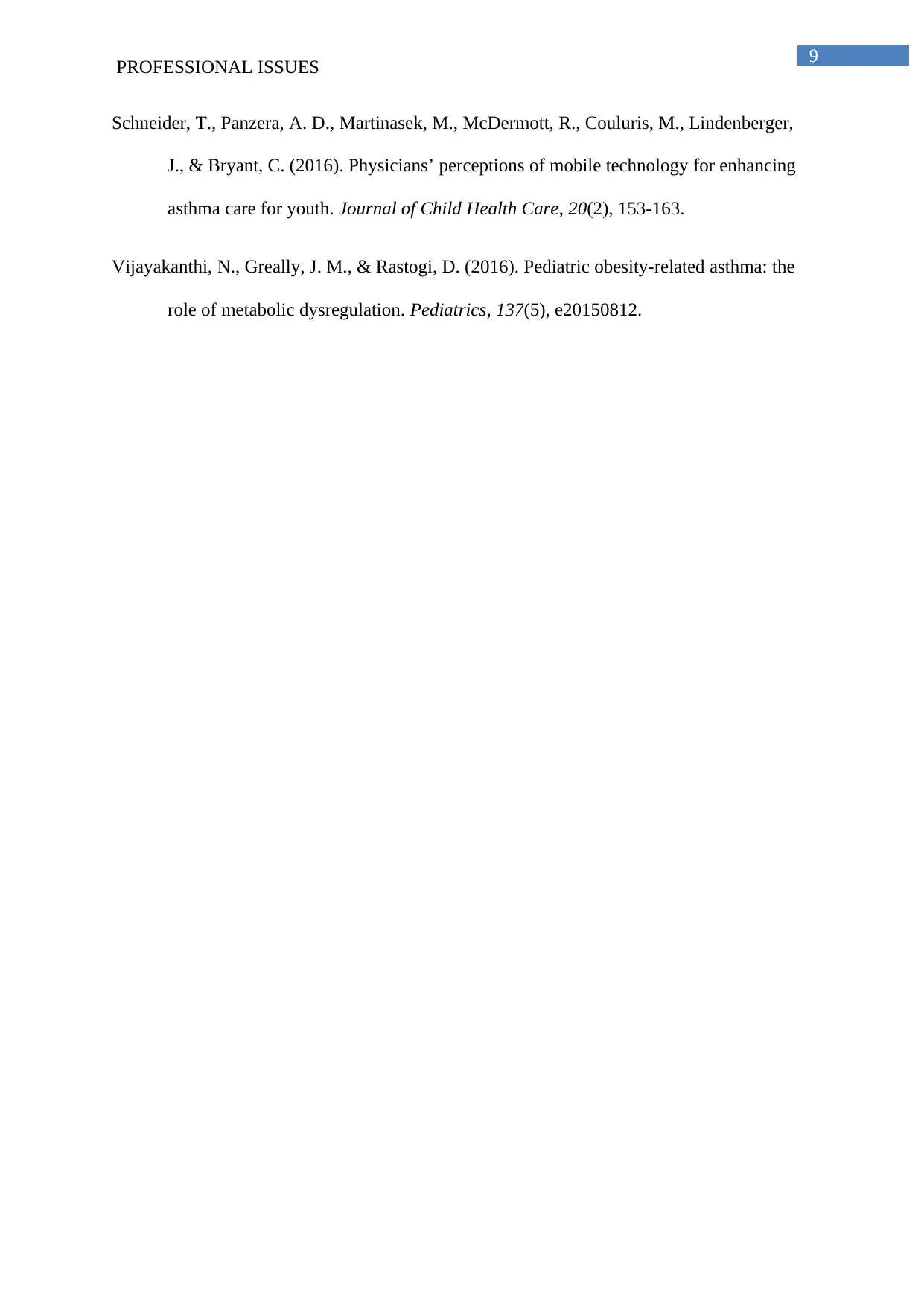
9
PROFESSIONAL ISSUES
Schneider, T., Panzera, A. D., Martinasek, M., McDermott, R., Couluris, M., Lindenberger,
J., & Bryant, C. (2016). Physicians’ perceptions of mobile technology for enhancing
asthma care for youth. Journal of Child Health Care, 20(2), 153-163.
Vijayakanthi, N., Greally, J. M., & Rastogi, D. (2016). Pediatric obesity-related asthma: the
role of metabolic dysregulation. Pediatrics, 137(5), e20150812.
PROFESSIONAL ISSUES
Schneider, T., Panzera, A. D., Martinasek, M., McDermott, R., Couluris, M., Lindenberger,
J., & Bryant, C. (2016). Physicians’ perceptions of mobile technology for enhancing
asthma care for youth. Journal of Child Health Care, 20(2), 153-163.
Vijayakanthi, N., Greally, J. M., & Rastogi, D. (2016). Pediatric obesity-related asthma: the
role of metabolic dysregulation. Pediatrics, 137(5), e20150812.
1 out of 10
Related Documents
Your All-in-One AI-Powered Toolkit for Academic Success.
+13062052269
info@desklib.com
Available 24*7 on WhatsApp / Email
![[object Object]](/_next/static/media/star-bottom.7253800d.svg)
Unlock your academic potential
Copyright © 2020–2025 A2Z Services. All Rights Reserved. Developed and managed by ZUCOL.





